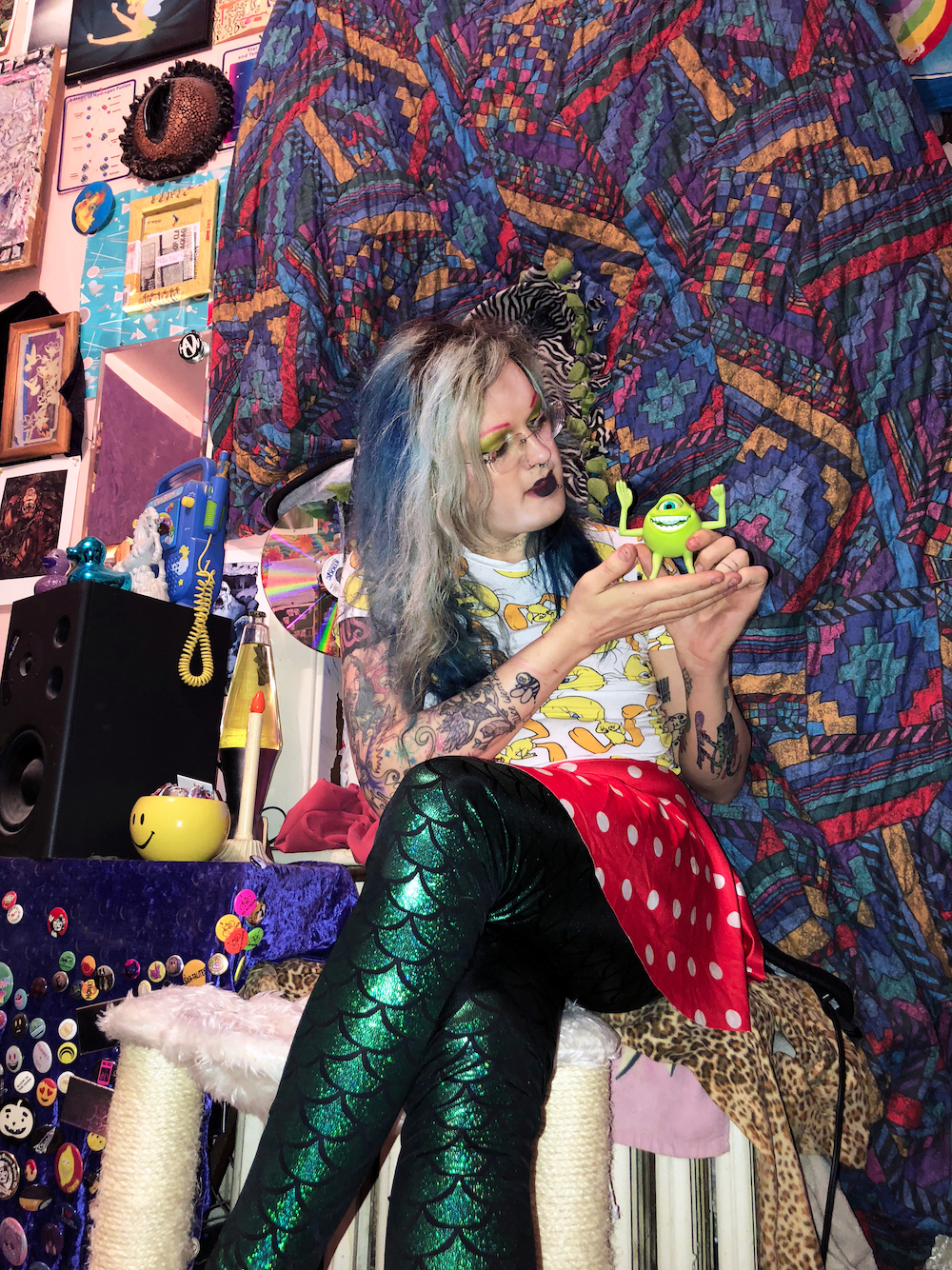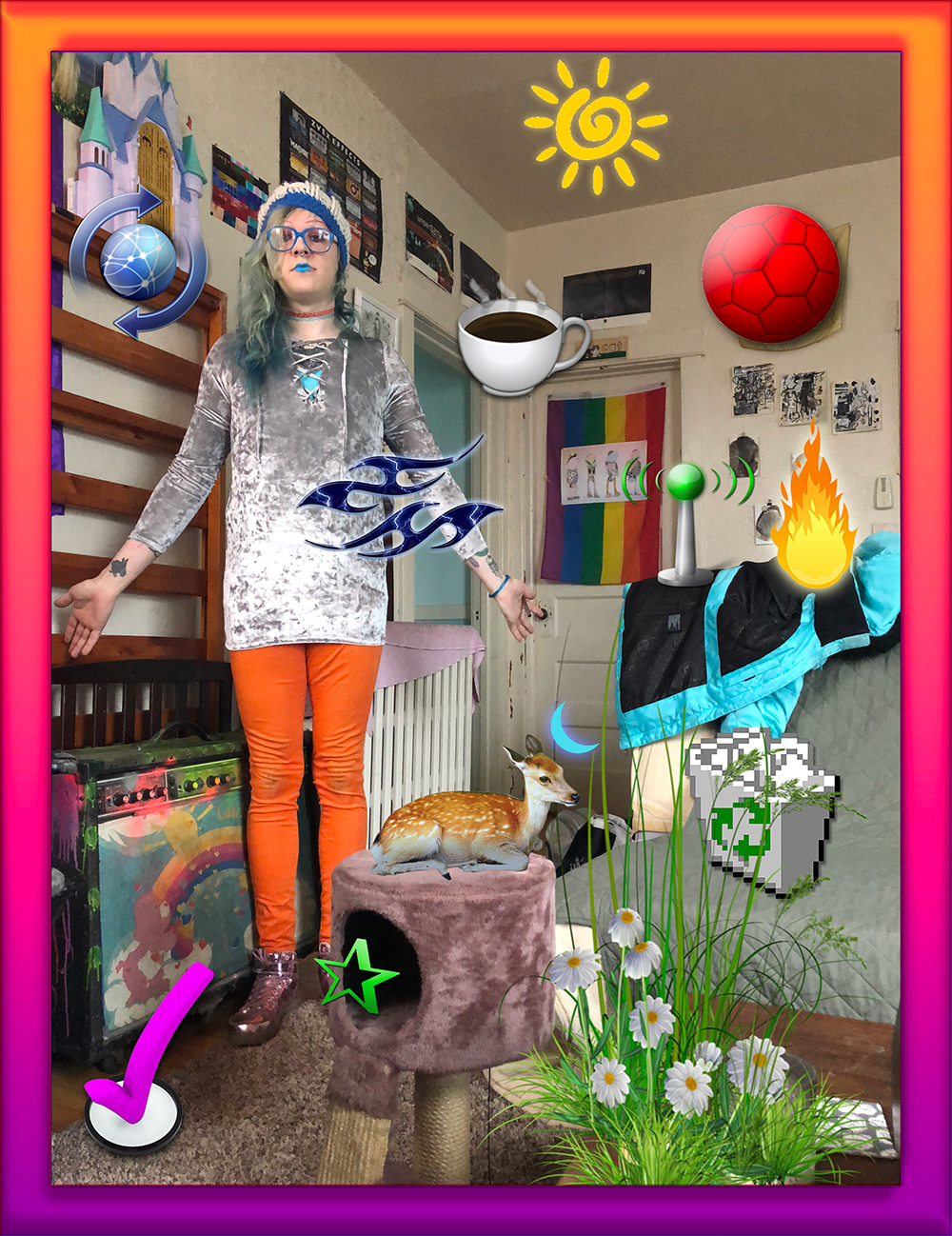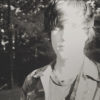Words ANGEL MARCLOID
Spirituality, philosophy, and psychology are not only my main academic subjects of choice, but they’ve helped light the colorful and complicated path I walk. I consider Skinless X-1, my new album on Hausu Mountain, to be my most “spiritual” release to date, although it may not outwardly appear as such. It references personal experiences, but the focus is more on an awareness of their nature. That awareness is something that the teachings of Jiddu Krishnamurti, Bhagavan Sri Ramana Maharshi, Eckhart Tolle, Guatama Buddha, and Laozi have all helped illuminate for me.
Skinless X-1 is loosely about being present with objects and forms such as physical environment, emotional experiences, and sensory memories (the observed), from the viewpoint of consciousness (the observer). And I can’t say subsequently released material won’t be largely based in the same….

THE MONKEY MIND
Some people have asked me about how Zen, meditation, or mindfulness is represented in my music. Those concepts are found in many lyrics and some imagery, but not so much in sounds the way you’d imagine. I’ve spent this decade moving (very fucking slowly) closer to mindfulness. When I compose music, in a way I exploit a part of my overactive mind. Ideas may pop into my head from a place of presence, but my decision making in the writing process is a free stream of thought. My mind has always been, as the author and speaker Eckhart Tolle puts it, “one damn thing after another.”
So when I write music, I give my “monkey mind” a job. Therefore it is occupied, not pre-occupied. It is focused, allowing itself to be as it is, but in a healthily controlled mental environment. Although this monkey of a mind has largely contributed to every hardship I’ve ever faced, part of mindfulness is accepting the true nature of that reality and then working with it rather than against it.
The song “Experience ☆ Slips ☆ Away” is my monkey mind in action. Ironically the song is about a longing for the present moment.
Everyone has a monkey mind. The monkey mind sounds like this: ‘I’m bored; I don’t want to study; I’m going to watch this video; I’m hungry; and blah blah blah.’
Monkey mind never stops talking. The monkey mind is always going here and there, and you cannot concentrate. Sometimes it makes us feel upset, or maybe it makes us angry, or jealous of others. You want to control your feelings, but monkey mind won’t stop talking. [You] cannot be happy if you just listen to the monkey mind.
Controlling the monkey mind is too difficult. It is too wild. What I say instead is: ‘guide the monkey mind’. Make friends with the monkey mind. The monkey mind likes when you give it small jobs, like ‘focus on [your] breath’. Once you give it jobs, the monkey mind starts to behave better, and you become the boss. —Buddhist monk Mingyur Rinpoche
More from Mingyur on the monkey mind in this silly video:
PRESENCE + NON-RESISTANCE
We all know that resistance to the oppressor is vital. But in that case, the definition of “resistance” is relative. Non-resistance, in the context of mindfulness, is vital. We must see “what is” in order to fully know something and take skillful action. This is what separates intellect from wisdom, studying from experiencing.
In my song “Window 2 Window”, I talk about cultivating true presence and non-resistance to everything around me, by referring to an actual meditation session I had sitting in the grass during a lunch break.
Just once in the grass, on my lunch break, I materialized right in the center. I let myself hear the meathooks, the MacBooks, every street crossing, every sidewalk slash, even Jesus Christ on a podcast. I place my hope in suburbia…. I’ve embraced my inner suburbia.
The term “inner suburbia” is a limiting and inefficient metaphor for “wide open space,” but a metaphor nonetheless. (It also relates to my obsession with suburban life… but that is a non-spiritual issue we won’t get into here because it requires discourse on racism, classism, capitalism, etc.) The references to MacBooks and “Jesus Christ on a podcast” have to do with tools of distraction and oppressive religious subculture respectively. They are two examples of things that require a deeper understanding in order to navigate them mindfully.
Here is an extremely profound excerpt from one of Jiddu Krishnamurti’s public lectures on presence:
And someone laid some tight Enigma-esque music over this great sound byte by Eckhart Tolle, where he talks about “rising above thinking,” a.k.a. presence:
INTERBEING
Interbeing is the name of my last album. It’s also the name of the first single from my new album Skinless X-1 (styled ✓ iNTERBEiNG). It is a term that was coined by Vietnamese Buddhist monk Thích Nhất Hạnh. His work is dear to my heart. He is known for his peace activism, especially during the Vietnam war. I first heard him talk about what Interbeing is on a YouTube video. He said:
If you are a poet, you will see clearly that there is a cloud floating in this sheet of paper. Without a cloud, there will be no rain; without rain, the trees cannot grow; and without trees, we cannot make paper. The cloud is essential for the paper to exist. If the cloud is not here, the sheet of paper cannot be here either. So we can say that the cloud and the paper inter-are.
‘Interbeing’ is a word that is not in the dictionary yet, but if we combine the prefix ‘inter’ with the verb ‘to be,’ we have a new verb, inter-be. If we look into this sheet of paper even more deeply, we can see the sunshine in it. If the sunshine is not there, the forest cannot grow. In fact, nothing can grow. Even we cannot grow without sunshine. And so, we know that the sunshine is also in this sheet of paper. The paper and the sunshine inter-are. And if we continue to look, we can see the logger who cut the tree and brought it to the mill to be transformed into paper. And we see the wheat. We know the logger cannot exist without his daily bread, and therefore the wheat that became his bread is also in this sheet of paper. And the logger’s father and mother are in it too.
When we look in this way, we see that without all of these things, this sheet of paper cannot exist. Looking even more deeply, we can see we are in it too. This is not difficult to see, because when we look at a sheet of paper, the sheet of paper is part of our perception. Your mind is here and mine is also. So we can say that everything is in here with this sheet of paper. You cannot point out one thing that is not here—time, space, the earth, the rain, the minerals in the soil, the sunshine, the cloud, the river, the heat.
Everything coexists with this sheet of paper. That is why I think the word inter-be should be in the dictionary. ‘To be’ is to be inter-be. You cannot just be by yourself alone. You have to inter-be. You cannot just be by yourself alone. You have to inter-be with every other thing. This sheet of paper, is because everything else is.
Suppose we try to return one of the elements to its source. Suppose we return the sunshine to the sun. Do you think that this sheet of paper will be possible? No, without sunshine nothing can be. And if we return the logger to his mother, then we have no sheet of paper either. The fact is that this sheet of paper is made up only of ‘non-paper elements.’ And if we return these non-paper elements to their sources, then there can be no paper at all. Without ‘non-paper elements’ like mind, logger, sunshine, and so on, there will be no paper. As thin as his sheet of paper is, it contains everything in the universe in it.
The lyrics to “✓ iNTERBEiNG” are an account of my own worldly observations, with the title acting as a reminder to myself that the things I observed inter-are.
Here is more on interconnectedness by the late philosopher Alan Watts.
FRIENDSHIP AND CURIOSITY
AS A MEANS OF RELATING
TO PAIN AND FEAR
The song “The Con-fused Little Hurricane” from my first album, Even The Files Won’t Touch You, features child-like vocal performances, a freeform emotional unloading I collaged together. At that time, I lived as if my own emotions were the most important things in the universe.
I hate it, but I’ll make friends with it. Friendship. My friend of hurt. My friend, the pain. My friend the confused hurricane. You’re my friend, hurt. I’ll make friends with pain and treat my rage with curiosity.
I was beginning to surrender to the idea of becoming curious about the deep pain and deafening fear I felt. I was moving closer to approaching it gently like a friend, rather than feeding my hatred for it. American Tibetan Buddhist nun Pema Chödrön taught me to try this, and it helped get me through a viciously dark time. It was so dark that I couldn’t even see I was making others’ lives dark, too. Pema said in her book The Wisdom of No Escape: And the Path of Loving-Kindness:
The idea isn’t to try to get rid of your anger, but to make friends with it, to see it clearly with precision and honesty, and also to see it with gentleness. That means not judging yourself as a bad person, but also not bolstering yourself up by saying, ‘It’s good that I’m this way, it’s right that I’m this way. Other people are terrible, and I’m right to be so angry at them all the time.’
The gentleness involves not repressing the anger but also not acting it out. It is something much softer and more openhearted than any of that. It involves learning how, once you have fully acknowledged the feeling of anger and the knowledge of who you are and what you do, to let it go. You can let go of the usual pitiful little storyline that accompanies anger and begin to see clearly how you keep the whole thing going.
So whether it’s anger or craving or jealousy or fear or depression—whatever it might be—the notion is not to try to get rid of it, but to make friends with it. That means getting to know it completely, with some kind of softness, and learning how, once you’ve experienced it fully, to let go.

MORE ON NAVIGATING
(NURTURING)
THE FEARFUL MIND
Fear, and the fear of fear, is a strong and common theme on the Drip Mental album. “Relevant Shambala Texts [CODENAME_INITIAL TOUCH LOCATION]” was originally an instrumental song with a different title, but I later decided to incorporate warped audio from Pema Chödrön attempting to recite a poem about fear from memory in a public talk. I also had my sister Megan write a short downtempo, acoustic guitar and voice-based excerpt using the words in Pema’s recital.
You can read the original poem below. These words were an encouragement and instruction on facing my own fears, dealing with street harassment and being in public, as well as navigating a truly terrible, frightening, sad, immobilizing breakup. At the end of the poem, it mentions seeing Great Eastern Sun. For me, seeing that is like seeing everything for how it is. In that seeing, I found that I was not the only one dealing with terror, fear, sadness, and immobilization in instances of harassment as well as the aforementioned break-up.
The Education of the Warrior
by Chögyam Trungpa RinpocheThat mind of fearfulness
Should be put in the cradle of loving-kindness
And suckled with the profound and brilliant milk
Of eternal doubtlessness.
In the cool shade of fearlessness,
Fan it with the fan of joy and happiness.
When it grows older,
With various displays of phenomena,
Lead it to the self-existing playground.
When it grows older still,
In order to promote the primordial confidence,
Lead it to the archery range of the warriors.
When it grows older still,
To awaken primordial self-nature,
Let it see the society of men
Which possesses beauty and dignity.
Then the fearful mind
Can change into the warrior’s mind,
And that eternally youthful confidence
Can expand into space without beginning or end.
At that point it sees the Great Eastern Sun.
EMPTINESS
The song “སྟོང་པོ་ཉིད་” from my Interbeing album, is titled after the Tibetan word for “emptiness,” pronounced śūnyatā. It is a commonly misunderstood word in Buddhism, and in a Google search you have to scroll through six pages of articles on the disambiguation before you get to any legitimate teaching on it. The meaning can waver depending on its doctrinal context. It’s not an easy concept to wrap your mind around. It cannot be fully understood without consciously experiencing it, and even then, words are extremely limiting. This is why the track is instrumental, ambient, simple.
Emptiness is referred to as ultimate truth, because it appears non-deceptively. Emptiness is the perception of an absence, the absence of the inherent existence of phenomena. To say that things are empty is to say that they dependently exist, that they are essenceless without their own nature or being. Buddhist emptiness is not the content of phenomena, or a universal essence or a source. It is the recognition that the way phenomena appear to inherently exist is unfindable and thus illusory. So again, emptiness is an absence, not a thing. When the belief in inherent existence is refuted, the emptiness, the groundlessness of all phenomena is realized. —Susan Kahn, emptinessteachings.com
Fire-Toolz’s new ‘Skinless X-1’ LP is now available through Hausu Mountain. For more on finding peace through music, check out self | centered, our new site devoted to ambient, New Age, and drone records.



